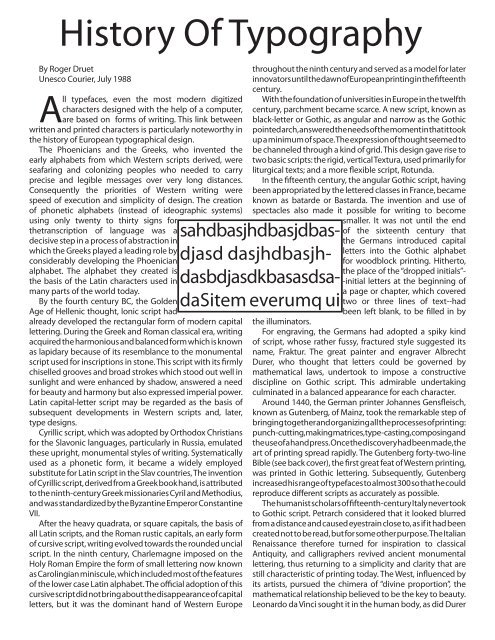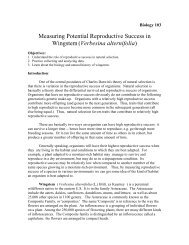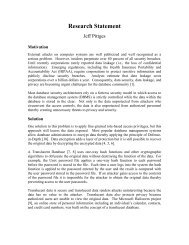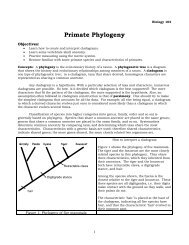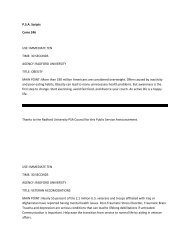History Of Typography - Radford University
History Of Typography - Radford University
History Of Typography - Radford University
Create successful ePaper yourself
Turn your PDF publications into a flip-book with our unique Google optimized e-Paper software.
<strong>History</strong> <strong>Of</strong> <strong>Typography</strong><br />
By Roger Druet<br />
Unesco Courier, July 1988<br />
All typefaces, even the most modern digitized<br />
characters designed with the help of a computer,<br />
are based on forms of writing. This link between<br />
written and printed characters is particularly noteworthy in<br />
the history of European typographical design.<br />
The Phoenicians and the Greeks, who invented the<br />
early alphabets from which Western scripts derived, were<br />
seafaring and colonizing peoples who needed to carry<br />
precise and legible messages over very long distances.<br />
Consequently the priorities of Western writing were<br />
speed of execution and simplicity of design. The creation<br />
of phonetic alphabets (instead of ideographic systems)<br />
using only twenty to thirty signs for<br />
thetranscription of language was a<br />
decisive step in a process of abstraction in<br />
which the Greeks played a leading role by<br />
considerably developing the Phoenician<br />
alphabet. The alphabet they created is<br />
the basis of the Latin characters used in<br />
many parts of the world today.<br />
By the fourth century BC, the Golden<br />
Age of Hellenic thought, Ionic script had<br />
already developed the rectangular form of modern capital<br />
lettering. During the Greek and Roman classical era, writing<br />
acquired the harmonious and balanced form which is known<br />
as lapidary because of its resemblance to the monumental<br />
script used for inscriptions in stone. This script with its firmly<br />
chiselled grooves and broad strokes which stood out well in<br />
sunlight and were enhanced by shadow, answered a need<br />
for beauty and harmony but also expressed imperial power.<br />
Latin capital-letter script may be regarded as the basis of<br />
subsequent developments in Western scripts and, later,<br />
type designs.<br />
Cyrillic script, which was adopted by Orthodox Christians<br />
for the Slavonic languages, particularly in Russia, emulated<br />
these upright, monumental styles of writing. Systematically<br />
used as a phonetic form, it became a widely employed<br />
substitute for Latin script in the Slav countries, The invention<br />
of Cyrillic script, derived from a Greek book hand, is attributed<br />
to the ninth-century Greek missionaries Cyril and Methodius,<br />
and was standardized by the Byzantine Emperor Constantine<br />
VII.<br />
After the heavy quadrata, or square capitals, the basis of<br />
all Latin scripts, and the Roman rustic capitals, an early form<br />
of cursive script, writing evolved towards the rounded uncial<br />
script. In the ninth century, Charlemagne imposed on the<br />
Holy Roman Empire the form of small lettering now known<br />
as Carolingian miniscule, which included most of the features<br />
of the lower case Latin alphabet. The official adoption of this<br />
cursive script did not bring about the disappearance of capital<br />
letters, but it was the dominant hand of Western Europe<br />
throughout the ninth century and served as a model for later<br />
innovators until the dawn of European printing in the fifteenth<br />
century.<br />
With the foundation of universities in Europe in the twelfth<br />
century, parchment became scarce. A new script, known as<br />
black-letter or Gothic, as angular and narrow as the Gothic<br />
pointed arch, answered the needs of the moment in that it took<br />
up a minimum of space. The expression of thought seemed to<br />
be channeled through a kind of grid. This design gave rise to<br />
two basic scripts: the rigid, vertical Textura, used primarily for<br />
liturgical texts; and a more flexible script, Rotunda.<br />
In the fifteenth century, the angular Gothic script, having<br />
been appropriated by the lettered classes in France, became<br />
known as batarde or Bastarda. The invention and use of<br />
spectacles also made it possible for writing to become<br />
smaller. It was not until the end<br />
sahdbasjhdbasjdbasdjasd<br />
dasjhdbasjhdasbdjasdkbasasdsadaSitem<br />
everumq ui<br />
of the sixteenth century that<br />
the Germans introduced capital<br />
letters into the Gothic alphabet<br />
for woodblock printing. Hitherto,<br />
the place of the “dropped initials”-<br />
-initial letters at the beginning of<br />
a page or chapter, which covered<br />
two or three lines of text--had<br />
been left blank, to be filled in by<br />
the illuminators.<br />
For engraving, the Germans had adopted a spiky kind<br />
of script, whose rather fussy, fractured style suggested its<br />
name, Fraktur. The great painter and engraver Albrecht<br />
Durer, who thought that letters could be governed by<br />
mathematical laws, undertook to impose a constructive<br />
discipline on Gothic script. This admirable undertaking<br />
culminated in a balanced appearance for each character.<br />
Around 1440, the German printer Johannes Gensfleisch,<br />
known as Gutenberg, of Mainz, took the remarkable step of<br />
bringing together and organizing all the processes of printing:<br />
punch-cutting, making matrices, type-casting, composing and<br />
the use of a hand press. Once the discovery had been made, the<br />
art of printing spread rapidly. The Gutenberg forty-two-line<br />
Bible (see back cover), the first great feat of Western printing,<br />
was printed in Gothic lettering. Subsequently, Gutenberg<br />
increased his range of typefaces to almost 300 so that he could<br />
reproduce different scripts as accurately as possible.<br />
The humanist scholars of fifteenth-century Italy never took<br />
to Gothic script. Petrarch considered that it looked blurred<br />
from a distance and caused eyestrain close to, as if it had been<br />
created not to be read, but for some other purpose. The Italian<br />
Renaissance therefore turned for inspiration to classical<br />
Antiquity, and calligraphers revived ancient monumental<br />
lettering, thus returning to a simplicity and clarity that are<br />
still characteristic of printing today. The West, influenced by<br />
its artists, pursued the chimera of “divine proportion”, the<br />
mathematical relationship believed to be the key to beauty.<br />
Leonardo da Vinci sought it in the human body, as did Durer
and the great French typographer Geofroy Tory, who studied<br />
the composition of letters according to the proportions of the<br />
human body in the Champfleury (1529), a treatise on type<br />
design.<br />
An important event which encouraged a new approach to<br />
printing was the sack of Mainz in 1462, which forced many<br />
of Gutenberg’s collaborators to leave the town. They took<br />
the secrets of printing to several European countries. Around<br />
1470 one of them, the French engraver Nicolas Jenson settled<br />
in Venice, where he drew inspiration from humanist scripts in<br />
designing a new type with wedge-shaped serifs. This pure and<br />
beautiful style was known as roman, a name which would in<br />
future be applied to typefaces with an upright design. Among<br />
the heirs to his workshop in that illustrious city was the<br />
learned Aldus Manutius, one of the great figures in European<br />
publishing. His type designer, Francesco Griffo of Bologna,<br />
cut the first example of a sloping type which became known as<br />
Aldine and is today called italic. It was based on the informal<br />
cursive writing developed by chancery clerks to speed their<br />
work.<br />
The sixteenth century was the Golden Age of calligraphy<br />
in Europe, rich in great calligraphers such as Ludovico degli<br />
Arrighi, Ugo da Carpi, Giovanniantonio Tagliente and Palatino<br />
in Italy, Jean Beauchenne in France and Roger Ascham in<br />
England. As progress was made in copper engraving, so a<br />
cursive script with slender finials (terminal hooks) emerged<br />
and came to fruition in the work of Lucas Matherot and Louis<br />
Barbedor.<br />
In France, where the development of printing was<br />
influenced by the work of Geofroy Tory, the Estienne family<br />
was prominent. One of its members, Robert Estienne, was<br />
printer to King Francois I. He entrusted Claude<br />
Garamond with a royal command to cut typefaces for<br />
editions of classical Greek texts. The famous Grecs du Roi<br />
which resulted were uncluttered and elegant. Garamond, the<br />
first commercial typefounder, also designed the roman and<br />
italic typefaces which bear his name and which played a<br />
leading role in European typographical design until the end of<br />
the sixteenth century.<br />
In this great humanist movement, Christophe Plantin , a<br />
French bookbinder who became a citizen of Antwerp and a<br />
printer, acted as a connecting link with the Netherlands, where<br />
a great dynasty of printers, the Elzeviers, had come to the fore<br />
and would be active until the beginning of the eighteenth<br />
century. The Elzeviers gave their name to an elegant wedgeserif<br />
typeface.<br />
In 1692, during the reign of Louis XIV and classicism,<br />
Abbe Nicolas Jaugeon of the French Academy of Sciences<br />
was given the task of creating a new typeface. His design, cut<br />
by Philippe Grandjean, was called Romain du Roi and was<br />
reserved for the exclusive use of the Imprimerie Royale--the<br />
Royal Press. This cold, majestic script was first used in 1702.<br />
The eighteenth century was an age of elegant typography in<br />
Britain. The typefounder William Caslon cut a highly legible<br />
typeface which is still in use today. Caslon was the typeface<br />
in which a Baltimore printer issued the official copies of the<br />
United States Declaration of Independence. Another English<br />
printer, John Baskerville, who taught calligraphy, designed a<br />
graceful, balanced typeface which revolutionized typography<br />
and is still popular.<br />
In eighteenth-century France, Louis-Rene Luce, engraver<br />
to King Louis XV, introduced the rational spirit of the<br />
Enlightenment and the Encyclopedists into typographical<br />
experimentation, while Pierre-Simon Fournier and Francois-<br />
Ambroise Didot invented the point system of typographic<br />
measurement. Both Didot’s son Firmin and Giambattista<br />
Bodoni of Parma were inspired by Baskerville’s work to<br />
create very similar forms of austere lettering with strongly<br />
contrasting thick and thin strokes. Their work influenced<br />
nineteenth-century type design in several countries.<br />
The development of lithography, a process of printing<br />
from a stone surface invented in 1796 by the dramatist Aloys<br />
Senefelder (see page 7), encouraged printing from types based<br />
on calligraphic script with fine, supple curves. From 1830<br />
onwards, as a result of scientific and technical advances and<br />
the development of industry and trade, a dynamic form of<br />
typography came into being through the work of typefounders<br />
such as Alexandre de Berny and Theophile Beaudoire.<br />
Egyptian, with its slab serifs, and Fat Face, still widely used in<br />
the press and advertising, were highly fashionable typefaces.<br />
William Morris, the poet and writer who made a major<br />
contribution to the revival of English decorative art in<br />
the late nineteenth century, was the leader of the Arts and<br />
Crafts Movement which took inspiration from the styles of<br />
medieval times. The work produced by his Kelmscott Press<br />
had a strongly individual graphic personality and exercised<br />
wide influence. In France, George Auriol and the painter<br />
and engraver Eugene Grasset were among the masters of Art<br />
Nouveau. The latter received support from the typefounder<br />
Georges Peignot, who later, with his son Charles, produced<br />
a range of typefaces which would dominate printing until the<br />
advent of phototypesetting in 1956. Peignot, designed by the<br />
French poster artist Adolphe Mouron Cassandre in 1937, and<br />
Bifur, a shaded script of great originality, are among the finest<br />
typefaces cut by the Deberny and Peignot typefoundry.<br />
Today, although computerization is widespread, there is a<br />
welcome revival of interest among young people in the art of<br />
calligraphy, which is encouraging the search for and creation<br />
of new designs. Outstanding modern designers of digitized<br />
letters include the great German calligrapher Hermann<br />
Zapf; Adrian Frutiger of Switzerland; Ladislas Mandel, Jose<br />
Mendoza, Albert Boton, all of France; as well as the young<br />
French designer of Arin, Franck Jalleau.<br />
We are at the dawn of a new age of typography. Lettering<br />
is no longer created by lead objects but by strokes of light.<br />
Photocomposition systems can now provide higher screen<br />
resolution, allowing sharper definition of characters, as well<br />
as an immense variety of typefaces, offering great scope<br />
for creativity. Soon, these machines will achieve a degree<br />
of sensitivity close to that of handwriting, and will give<br />
typographers a degree of control over the design of lettering<br />
far superior to that of early electronic typesetting systems. But<br />
to safeguard an entire heritage of craftsmanship, metal type<br />
must not be allowed to disappear.


